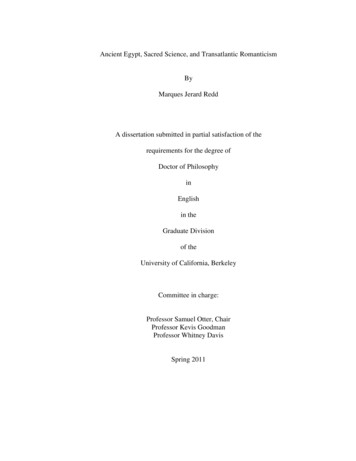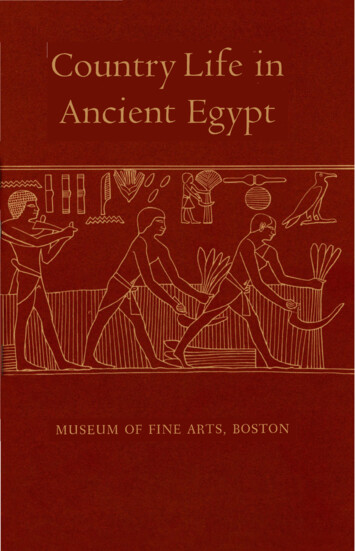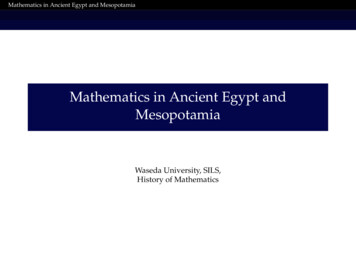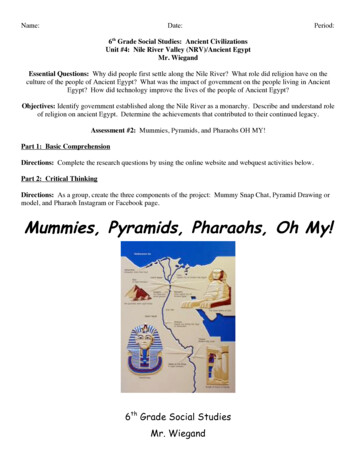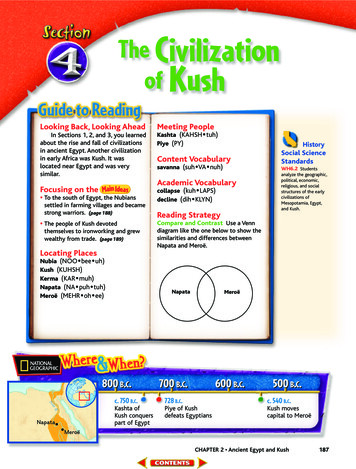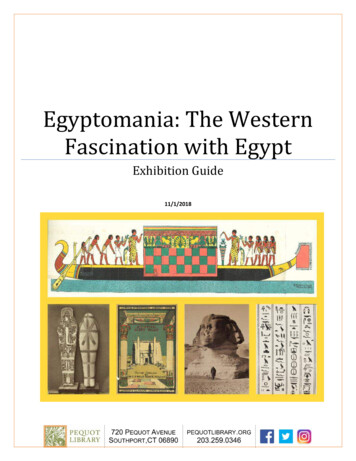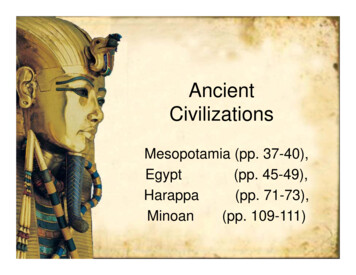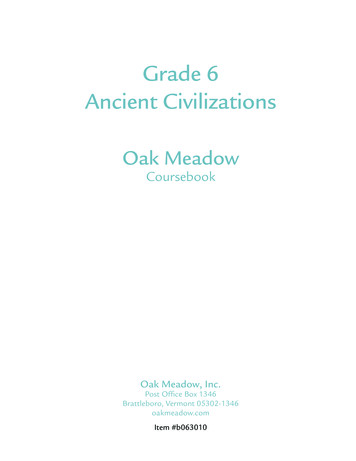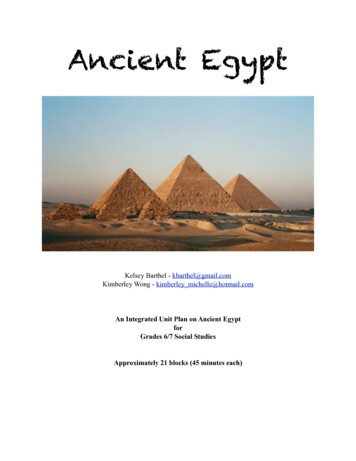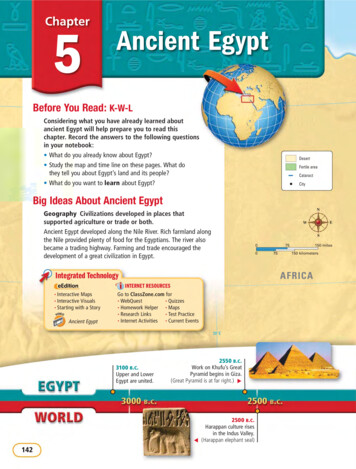
Transcription
Chapter5Ancient EgyptBefore You Read: K-W-LConsidering what you have already learned aboutancient Egypt will help prepare you to read thischapter. Record the answers to the following questionsin your notebook: What do you already know about Egypt?Desert Study the map and time line on these pages. What dothey tell you about Egypt’s land and its people? What do you want to learn about Egypt?Fertile areaCataractCityBig Ideas About Ancient EgyptNGeography Civilizations developed in places thatsupported agriculture or trade or both.Ancient Egypt developed along the Nile River. Rich farmland alongthe Nile provided plenty of food for the Egyptians. The river alsobecame a trading highway. Farming and trade encouraged thedevelopment of a great civilization in Egypt.S00INTERNET RESOURCESInteractive Maps Interactive Visuals Starting with a StoryAncient EgyptGo to ClassZone.com for WebQuest Quizzes Homework Helper Maps Research Links Test Practice Internet Activities Current Events20 E2550 B.C .Work on Khufu’s GreatPyramid begins in Giza.(Great Pyramid is at far right.) 3100 B.C.Upper and LowerEgypt are united.1427575150 miles150 kilometersAFRICAIntegrated Technology EW2500 B.C .Harappan culture risesin the Indus Valley.(Harappan elephant seal)
ASIAAncient Egypt, 3100–1200 B.C.M e d i t e r r a n e a nS e a30 NTanisN i l e D e l t a Pi-RamsesThe Great Sphinx in GizaGizaSaqqaraMemphisSinaiPeninsulaGulf ofSuezeetseerrnAbydostReVALLEY OFTHE KINGSseedrThebestNilVALLEY OFTHE QUEENSP E N I N S U L ADDsne rs tE aTell el-‘AmârnaThe step pyramid in SaqqaraWA R A B I A NSe RivereaTropic oSyeneFirstCataractQueen Hatshepsut’s Temple in ThebesaharaAbu SimbelSecondCataractKing Ramses II’s Templein Abu Simbel30 E20 N1720 B.C.Hyksos invade Egypt.1790 B.C.Hammurabi’s Code issued inthe Babylonian Empire.1472 B.C.1279 B.C.Hatshepsut, first womanpharaoh, comes to power.Ramses II beginshis 66-year reign.1760 B.C.1200 B.C.Shang Dynasty comesto power in China.Olmec rise in Mexico.(Olmec giant stone head) Sf Cancer143
Background: Egypt was one of the longestlasting world empires. For almost 3,000 years,kings called pharaohs ruled the land. One of themost dazzling of all was Ramses II (RAM SEEZ),who reigned from about 1279 to 1213 B.C. At atime when few Egyptians lived beyond the ageof 40, Ramses II was in charge for 66 years!Now he has finally died, and Egypt preparesfor his funeral. Imagine you are there as theleader of Egypt’s golden age is laid to rest. Statue of Ramses II144
Starting with a StoryYou are a professional mourner, a person whose job is to cry atfunerals. In the past, you’ve helped to bury some important people—but never a pharaoh! Your white mourning robe is spotless. Youspent hours preparing the wreath of flowers to crown your head.No one remembers any other pharaoh. Ramses II ruled Egypt whenyour grandparents were children. Some people thought he would liveforever. Now he’s dead and headed for his tomb in the Valley of the Kings.The ceremony began at his temple at Abu Simbel. At that temple, four 66foot statues of Ramses II guard the entrance. Inside the secret chambers,priests preserved the pharaoh’s body for burial.Next, a royal barge carried Ramses’ casket on the Nile River. Inside isthe pharaoh’s mummy, wrapped in orange linen and wearing a gold mask.Hundreds of important Egyptians are waiting at the tomb.It’s time to begin the procession. You line up with other mournersbehind a group of slaves carrying Ramses’ most important possessions.There is his sword! Could it be the one he carried into battle when hefought Egypt’s enemy, the Hittites? Who will stop the Hittites now?Tearing your hair and beating your chest, you wail your song of sorrow:“Great lord of our empire! Provider of lasting peace! Builder of temples thatreach for the sun! Don’t leave us! Without you, we are fatherless children!”Sometimes you fake your cries at funerals, but today you mean everyword. Trembling with fear, you wonder what will happen now.What do you hope the new pharaohwill be like?1. READING: Reading Aloud What parts of this storybenefit most from being read with appropriate intonationand expression?2. WRITING: Narration Suppose you are waiting to hearRamses’ son, the new pharaoh, speak for the first time.Write a brief scene in which you discuss your hopes andfears for Egypt with others in the crowd.145
Lesson1MAIN IDEASGeography The Nile River helpedEgypt develop a civilization.Economics The fertile land providedeverything Egyptians needed.Economics The Nile and otherresources influenced Egypt’s economy.TAKING NOTESReading Skill:Understanding Cause and EffectFollowing causes and effects will help youunderstand the main ideas in this lesson. InLesson 1, look for the effects of each event listedin the chart. Record them on a chart of your own.CausesImage is not available forelectronic use. Please referto the image in the textbook. Lotus Pendants This necklaceonce belonged to an Egyptianking. The pendants at the bottomare lotus buds. The lotus, a waterlily that grows in the Nile River,is a symbol of Egypt.EffectsFloodsNew agriculturaltechniquesMany land resourcesSkillbuilder Handbook, page R26Words to KnowUnderstanding the following words will help you read this lesson:fine made of very smallparticles (page 147)The fine soil was more likedust than sand.146 Chapter 5barren lacking plants orcrops (page 148)While crops grew well nextto the Nile River, the desertwas barren.noble a member of awealthy and powerfulfamily (page 149)The nobles could affordmore comfortable homesthan could most people.sought tried to find(page 150)The Egyptians sought ironbecause it was good formaking tools.
TERMS & NAMESGift of the NilecataractdeltasiltfertileBuild on What You Know Have you ever received a giftthat was very important to you? How did it affect your life?The Nile River was so important to Egypt that 2,500 yearsago, an ancient Greek historian called Egypt “the gift ofthe Nile.”linenGeography of Ancient EgyptESSENTIAL QUESTION Why was the Nile River important?The Greek historian knew what he was talking about. TheNile River fed Egyptian civilization for hundreds of years.The Longest River The Nile is 4,160 miles long—theworld’s longest river. It begins near the equator in Africa andflows north to the Mediterranean Sea. In the south it churnswith cataracts. A cataract (KAT uh RAKT) is a waterfall. Nearthe sea the Nile branches into a delta. A delta is an area neara river’s mouth where the water deposits fine soil called siltsilt.In the delta, the Nile divides into many streams.The river is called the upper Nile in the south and thelower Nile in the north. For centuries, heavy rains in Ethiopiacaused the Nile to flood every summer. The floods depositedrich soil along the Nile’s shores. This soil was fertilefertile, whichmeans it was good for growing crops. Unlike the Tigris andEuphrates, the Nile River flooded at the same time every year,so farmers could predict when to plant their crops.The Nile ValleyFertile land in Egyptstretches along theNile and then givesway to desert. As aresult, Egypt was anarrow country. 147
Red Land, Black Land The ancient Egyptians lived in narrowbands of land on each side of the Nile. They called this region theblack land because of the fertile soil that the floods deposited.The red land was the barren desert beyond the fertile region.Weather in Egypt was almost always the same. Eight monthsof the year were sunny and hot. The four months of winter weresunny but cooler. Most of the region received only an inch ofrain a year. The parts of Egypt not near the Nile were a desert.Isolation The harsh desert acted as a barrier to keep outenemies. The Mediterranean coast was swampy and lacked goodharbors. For these reasons, early Egyptians stayed close to home.What did the floods of the Nile River provide for farmers?Land of PlentyESSENTIAL QUESTION How did Egyptians use the land around the Nile?Each year, Egyptian farmers watched for white birds called ibises(EYE bihs uhz), which flew up from the south. When the birdsM e d i t e r ra n e a nS e aGeography of Ancient Egypt, 3000–2000 B.C.Nile DeltaLOWEREGYPT30 NMemphisDesert (red land)SinaiPeninsulaFertile area(black land)Direction of NileRiver current0100100200 miles200 kilometerse dFirstCataractTropic of CancSINTERPRETING MAPSMovement How did the directione aNUBIA30 E148 Chapter 525 NRGEOGRAPHY SKILLBUILDERof the wind and of the Nile currentshelp trade grow between Egypt andregions to the south?Thebeste re sS0Nile Delta The Nile delta is darkbrown in this satellite image.DEUPPEREGYPTrveRiD e s e r tNWNileW e s t e r nDirection of windne rs tE aCataract35 E40 Eer
arrived, the annual flood waters wouldsoon follow. After the waters drainedaway, farmers could plant seeds in thefertile soil.Agricultural Techniques By about2400 B.C., farmers used technologyto expand their farmland. Workingtogether, they dug irrigation canalsthat carried river water to dry areas.Then they used a tool called a shaduf(shah DOOF) to spread the water acrossthe fields. These innovative, or new,techniques gave them more farmland.Egyptian Crops Ancient Egyptians grew a large varietyof foods. They were the first to grind wheat into flour andto mix the flour with yeast and water to make dough riseinto bread. They grew vegetables such as lettuce, radishes,asparagus, and cucumbers. Fruits included dates, figs,grapes, and watermelons.Egyptians also grew the materials for their clothes. Theywere the first to weave fibers from flax plants into a fabriccalled linenlinen. Lightweight linen cloth was perfect for hotEgyptian days. Men wore linen wraps around their waists.Women wore loose, sleeveless dresses. Egyptians also wovemarsh grasses into sandals.Egyptian Houses Egyptians built houses using bricksConnect to Today Shaduf A shaduf isa bucket on a lever. Itwas used to lift waterfrom the Nile or canals.Some Egyptians still useshadufs today.Vocabulary StrategyThe word linen hasmultiple meanings.Sheets and tableclothsare often called linensbecause they used toonly be made fromlinen cloth.made of mud from the Nile mixed with chopped straw.They placed narrow windows high in the walls to reduce brightsunlight. Egyptians often painted walls white to reflect theblazing heat. They wove sticks and palm trees to make roofs.Inside, woven reed mats covered the dirt floor. Most Egyptiansslept on mats covered with linen sheets. Wealthy citizensenjoyed bed frames and cushions.Egyptian nobles had fancier homes with tree-lined courtyardsfor shade. Some had a pool filled with lotus blossoms and fish.Poorer Egyptians simply went to the roof to cool off after sunset.They often cooked, ate, and even slept outside.What agricultural techniques did ancient Egyptians use?Ancient Egypt 149
Geography ShapesEgyptian LifeESSENTIAL QUESTION Whateconomic activities developedin Egypt?Egypt’s economy depended onfarming. However, the naturalresources of the area allowedother economic activities todevelop too.Mining The Egyptianswanted valuable metals thatwere not found in the black land.For example, they wanted copperto make tools and weapons. Egyptianslooked for copper as early as 6000 B.C. Later Hunter This wallthey learned that iron was stronger, and theypainting from a tombsought it as well. Ancient Egyptians also desired gold for itsshows a man huntingmarsh birds.bright beauty. The Egyptian word for gold was nub. Nubiawas the Egyptian name for the area of the upper Nile thathad the richest gold mines in Africa.Mining minerals was difficult. Veins (long streaks) of copper,iron, and bronze were hidden inside desert mountains in thehot Sinai Peninsula, east of Egypt. Even during the cool season,chipping minerals out of the rock was miserable work.Egyptians mined precious stones too. They were probably thefirst people in the world to mine turquoise (TUR KWOYZ). TheEgyptians also mined lapis lazuli (LAP ihs LAZ uh lee). Thesebeautiful blue stones were used in jewelry.Fishing and Hunting The Nile had fish and other wildlifethat Egyptians wanted. To go on the river, Egyptians madelightweight rafts by binding together reeds. They used everythingfrom nets to harpoons to catch fish. One ancient painting evenshows a man ready to hit a catfish with a wooden hammer.More adventurous hunters speared hippopotamuses andcrocodiles along the Nile. Egyptians also captured quail withnets. They used boomerangs to knock down flying ducks andgeese. (A boomerang is a curved stick that returns to the personwho threw it.)150 Chapter 5
Transportation and Trade Eventually, Egyptians equipped theirreed boats with sails and oars. The Nile then became a highway. Theriver’s current was slow, so boaters used paddles to go faster whenthey traveled north with the current. Going south, they raised a sailand let the winds that blew in that direction push them.The Nile provided so well for Egyptians that sometimes theyhad surpluses, or more goods than they needed. They began totrade with each other. Ancient Egypt had no money, so peopleexchanged goods that they grew or made. This method of tradeis called bartering.Turquoise JewelryThis bracelet hasturquoise and otherprecious stones. How did geography affect Egypt’s economy?Lesson Summary The Nile River created a fertile land in a desert. The Egyptians used technology to expand theirfarms and grow many crops. Ancient Egyptians also mined, fished, hunted,and traded.Image is not availablefor electronic use.Please refer to theimage in the textbook.Why It Matters Now . . .Ancient Egyptians invented many things we use today,such as yeast bread, turquoise jewelry, and linen clothes.1Homework HelperClassZone.comTerms & Names1. Explain the importance ofcataractsiltlinendeltafertileUsing Your NotesUnderstanding Cause and Effect Use yourcompleted chart to answer the following question:2. How did new agricultural techniques make theEgyptians more prosperous? (6.2.2)CausesEffectsFloodsMain Ideas3. Why did Egypt develop along the Nile? (6.2.1)4. How did irrigation canals expand farmland inEgypt? (6.2.2)5. How did trade along the Nile come about? (6.2.6)Critical Thinking6. Making Inferences How did climate affect thedaily lives of Egyptians? (6.2.1)7. Drawing Conclusions Analyze the gifts ofthe Nile in terms of innovation and culturalendurance. (6.2.1)New agriculturaltechniquesMany land resourcesMaking a Sketch Create a sketch showing the different types of economic activities that tookplace in ancient Egypt. (6.2.2)Ancient Egypt 151
Research LinksClassZone.comExtend Lesson 1.ILPurpose: To learn about the life ofEgyptian traders on the Nile RiverIf you were an Egyptian trader, you would sail theNile River in a boat that looks much like the oneshown here. Traders carried their goods in reedboats that they sailed up and down the Nile. Asshown below, the simple boat held everything thetraders needed for their trip on the river.A Hull In the hull below the boat’s deck, you storebarrels of fruit and sacks of barley and wheat.B Sails You raise your linen sail to catch the windwhen you travel south on the Nile against thecurrent. You lower the sail when you travel with thecurrent north on the Nile.C Oars The boat has a basket and oar at either end.Once the boat sets sail, you or another trader willstand in the basket and use the oar to steer.D On Deck There is much activity on the boat’s deck,as you store more goods and tie up the sheep andgoats you plan to barter.E River Animals A pair of ibises and some hipposfeed as you load your boat. But you keep your eyeon the crocodiles—the most dangerous animals onthe Nile.152 Chapter 5 EAD3E22ELife on the Nile River-EDITERRANEAN3EA
1. TALK ABOUT IT What weresome of the advantages of beingan Egyptian trader? What weresome of the disadvantages?2. WRITE ABOUT IT Imagineyou are an Egyptian trader andwrite a diary entry about a dayspent sailing the Nile. You couldwrite about the goods you’replanning to trade or about theanimals you see during your trip.Ancient Egypt 153
Lesson2MAIN IDEASEconomics Egyptians developed a complexsociety with many different jobs and social roles.Science and Technology Egyptians madeadvances in calendars, geometry, medicine, andother areas.Belief Systems Egyptians believed in many godsand a happy life after death.TAKING NOTESReading Skill: Categorizing Sorting information intogroups helps you understand patterns in history. In Lesson2, look for three categories of Egyptian culture and detailsabout them. Record the information on a web diagram.LearningReligionEgyptianculture Cat Mummy SomeEgyptians made their deadpets into mummies and gavethem a formal burial. Catswere especially honoredin Egypt.Work andfamilySkillbuilder Handbook, page R6Words to KnowUnderstanding the following words will help you read this lesson:formal carried out in aceremonial manner(page 156)The priest obeyed thechurch’s formal rituals ashe performed the service.154 Chapter 5garment a piece ofclothing (page 156)deed an action done byThe garments that priestswore were made of linen.People were judged moreby their deeds than by theirwords.a person (page 160)
Life inAncient EgyptBuild on What You Know As you have seen, EgyptTERMS & ospered along the Nile. This prosperity made life easierand provided greater opportunities for many Egyptians.Work and Family LifeESSENTIAL QUESTION How did work and social roles affect peoplein ancient Egypt?When farmers produce food surpluses, the society’s economybegins to expand. Cities emerge as centers of culture andpower, and people learn to do jobs that do not involveagriculture. For example, some ancient Egyptians learned tobe scribesscribes, people whose job was to write and keep records.Specialized Jobs As Egyptian civilization grew morecomplex, people took on jobs other than that of a farmer orscribe. Some skilled artisans erected stone or brick housesand temples. Other artisans made pottery, incense, mats,furniture, linen clothing, sandals, or jewelry.A few Egyptians traveled to the upper Nile to trade withother Africans. These traders took Egyptian products suchas scrolls, linen, gold, and jewelry. They brought back exoticwoods, animal skins, and live beasts.Luxor, Egypt Skilledartisans helped tobuild this templeand the shafts withpointed tops, whichare called obelisks. 155
Rulers and Priests As Egypt grew, so did its need to organize.Egyptians created a government that divided the empire into 42provinces. Many officials worked to keep the provinces runningsmoothly. Egypt also created an army to defend itself.One of the highest jobs in Egypt was to be a priest. Priestsfollowed formal rituals and took care of the temples. Beforeentering a temple, a priest bathed and put on special linengarments and white sandals. Priests cleaned the sacred statues intemples, changed their clothes, and even fed them meals.Egyptian Social RolesPharaoh The ruler, called thepharaoh, was above all otherpeople because he or she wasconsidered a god.Priests The priests caredfor the temples and heldceremonies to keep thegods happy.SKILLBUILDERINTERPRETING VISUALSPharaohWhat activities do you seebeing performed in thischart? At what level of thepyramid is most of the hardphysical labor done?Priests and NoblesScribes The scribes weretrained in the art of writingand record keeping.Scribes and Government OfficialsFarmers, Laborers,and Slaves Thelargest segment of thepopulation was madeup of farmers, laborers,and slaves.Craftspeople and MerchantsFarmersLaborers and Slaves156 Chapter 5
Together, the priests and the ruler held ceremonies to pleasethe gods. Egyptians believed that if the gods were angry, the Nilewould not flood. As a result, crops would not grow, and peoplewould die. So the ruler and the priests tried hard to keep thegods happy. By doing so, they hoped to maintain the social andpolitical order.Slaves Slaves were at the bottom of society. In Egypt, peoplebecame slaves if they owed a debt, committed a crime, or werecaptured in war. Egyptian slaves were usually freed after a periodof time. One exception was the slaves who had to work in themines. Many died from the exhausting labor.Life for Women Egypt was one of the best places in theancient world to be a woman. Unlike other ancient Africancultures, in Egyptian society men and women had fairly equalrights. For example, they could both own and manage theirown property.The main job of most women was to care for their childrenand home, but some did other jobs too. Some womenwove cloth. Others worked with their husbands in fields orworkshops. Some women, such as Queen Tiy, even rose toimportant positions in the government.Childhood Children in Egypt played with toys such as dolls,animal figures, board games, and marbles. Their parents madethe toys from wood or clay. Boys and girls also played roughphysical games with balls made of leather or reeds.Boys and some girls from wealthy families went to schoolsrun by scribes or priests. Most other children learned theirparents’ jobs. Almost all Egyptians married when they were intheir early teens.What were the levels of Egyptian society?Expanding KnowledgeESSENTIAL QUESTION How did learning advance in ancient Egypt?As in many ancient societies, much of the knowledge of Egyptcame about as priests studied the world to find ways to please thegods. Other advances came about because of practical discoveries.Ancient Egypt 157
Astronomy Egyptian priests studied the sky as part of theirreligion. About 5,000 years ago, they noticed that a star nowcalled Sirius (SIHR ee uhs) appeared shortly before the Nilebegan to flood. The star returned to the same position in 365days. Based on that, Egyptians developed the world’s firstpractical calendar.Geometry The Egyptians developed some of the first geometry.Each year the Nile’s floods washed away land boundaries. Torestore property lines, surveyors measured the land by usingropes that were knotted at regular intervals.Geometric shapes such as squares and triangles were sacredto Egyptians. Architects used them in the design of royal templesand monuments.Medicine Egyptian doctors often prepared dead bodies forburial, so they knew the parts of the body. That knowledgehelped them perform some of the world’s first surgery. Somedoctors specialized in using medicines made of herbs.Egyptian medicine was far from perfect. Doctors believedthat the heart controlled thought and the brain circulated blood,which is the opposite of what is known now. Some Egyptiantreatments would raise eyebrows today. One “cure” for an upsetstomach was to eat a hog’s tooth crushed inside sugar cakes!Hieroglyphs Beginning about 3000 B.C., Egyptiansdeveloped a writing system using hieroglyphs. Hieroglyphs(HY uhr uh GLIHFS) are pictures that stand for differentwords or sounds. Early Egyptians created a hieroglyphicsystem with about 700 characters. Over time the systemgrew to include more than 6,000 symbols.The Egyptians also developed a paperlike material called papyrus (puh PY ruhs)from a reed of the same name. Egyptianscut the stems into strips, pressed them,and dried them into sheets that couldbe rolled into scrolls. Papyrus scrollswere light and easy to carry. With them,Egyptians created some of the first books.What advances in learning did theEgyptians make?158 Chapter 5 Scribe A person whowanted to be a scribe had tostudy many years to learn allof the hieroglyphs.
These symbolsrepresent the nameof ruler Senusret I.HieroglyphsThe ancient Egyptians used hieroglyphsin many ways, as shown in this carvingof Senusret I, a ruler from the 1900s B.C.These picturesstand for the idea“given life.” They could be simple picturewriting. For example, a wavy linemight mean “water.” Some pictures stood for ideas. Acircle often meant Re, the sun god. Finally, some signs also came torepresent sounds. For example, thesigns below represent the nameof Cleopatra, a foreign queen whowould later rule Egypt. , % 0 ! 42These symbolsrepresent the nameof the Egyptiangod Amon.!4DOCUMENT–BASED QUESTIONWhat do you think is the purpose ofthe hieroglyphs on this carving?Beliefs and ReligionESSENTIAL QUESTION What religious beliefs did Egyptians hold?We know from their writing and their art that, in general, theEgyptians had a positive view of life. The black land providedmost of the Egyptians’ needs. As a result, they did not have tostruggle to make a living.Life After Death Their positive outlook shaped theirVocabulary Strategyreligion and led them to believe that the gods favoredthem. Egyptians believed that their prosperity couldcontinue with a happy afterlife. An afterlife is a lifebelieved to follow death. Not every ancient culture sharedEgyptians’ beliefs. For example, the Sumerians thoughtthat the afterlife was miserable.Afterlife is acompound word.You can divide it intothe words after andlife. An afterlife is alife believed to followdeath.Ancient Egypt 159
Judgment of the Dead Egyptians believed that bad deeds made a heart heavy.They thought that the god Anubis weighed each dead person’s heart, as shown inthis Egyptian art. If it was lighter than a feather, the reward was a happy afterlife.If the heart was heavier than a feather, Anubis fed it to a monster.Many Gods As you have learned in Chapter 3, polytheism isa belief in many gods. The Egyptians worshiped gods that wererelated to the afterlife and to parts of nature—such as the sun,the river, and plant life. Some of the most important Egyptiangods included Re (ray)—the sun god (later called Amon-Re) Osiris (oh SY rihs)—a god who judgedEgyptians after death Isis (EYE sihs)—a fertility goddess who wasOsiris’ wife Anubis (uh NOO bihs)—a god of the deadMaking Mummies Egyptians thought they would needtheir bodies in the afterlife, so they embalmed dead people.Embalm means to preserve a body after death. First, embalmersremoved all organs except the heart. Next, they filled the bodywith a mixture of salt and herbs to create a mummy. A mummyis a body that has been dried so it won’t decay. When dry, themummy was wrapped in hundreds of yards of linen strips. Thewhole process of embalming and wrapping took about 70 days.Embalming was expensive, and not everyone could afford it.160 Chapter 5Primary SourceHandbookSee the excerpt fromthe Book of the Dead,page R39.
The mummy was placed in a coffin inside a tomb. The tombalso held everyday objects, furniture, and food. Scenes from theperson’s life were painted on the walls. The Egyptians expectedthese pictures to become real so that the dead person could usethem in the afterlife.What did the Egyptians think happened after death?Anubis Egyptiansbelieved the jackalheaded god Anubisweighed their heartsafter death. Lesson Summary The Egyptians developed a calendar, earlygeometry, medical knowledge, andhieroglyphic writing. Ancient Egypt had a complex society withspecialized jobs. Women and slaves lived betterthere than in many other ancient lands. The Egyptians believed in many gods related tonature. They also believed in a happy afterlife.Why It Matters Now . . .The ancient Egyptians were the first people knownto develop a formal religion based on a belief in theafterlife. Such a belief is part of most religions today.2Homework HelperClassZone.comTerms & Names1. Explain the importance ofscribepapyrushieroglyphafterlifeembalmmummyUsing Your NotesCategorizing Use your completed web diagram toanswer the following question:2. What jobs did Egyptians hold?ReligionLearningEgyptiancultureMain Ideas3. Why were some Egyptians able to becomeartisans?4. How were hieroglyphs used?5. What duties did priests have?Critical Thinking6. Understanding Cause and Effect Why wereEgyptian discoveries in astronomy and medicineimportant?7. Making Generalizations How did the Nileaffect the Egyptians’ view of the afterlife?Work andfamilyWriting in Hieroglyphs Use the hieroglyphs shown on page 159 to writea few words.Ancient Egypt 161
Research LinksClassZone.comExtend Lesson 2The Legacy of EgyptPurpose: To learn about the impact that Egyptianknowledge and learning have on people todayYou may feel little connection with the ancient Egyptians as youlearn about their civilization. Yet our civilization owes a greatdeal to the Egyptians. They left behind a rich heritage in scienceand mathematics that we continue to build on today.Calendars Past Around 4000 B.C., the Egyptiansdeveloped a 365-day calendar based on thestar Sirius. This fragment from a tomb paintingshows the Egyptian concept of time. The redcircles represent the months of the year. Thelarge circles, which are divided into 24 hours,symbolize religious holidays. Present The Egyptiancalendar is the basis for themodern Western calendar.Still, the calendar in thehandheld computer shownhere can do things thatancient Egyptians neverdreamed of—includingmeasuring minutes andseconds. Egyptians did nothave names for units of timesmaller than an hour.162 Chapter 5
Medical KnowledgePresent Egyptianmedicine providedthe foundation formodern medicine.Our instrumentshave become moresophisticated, such asthose used for lasersurgery. But doctorstoday still use thethree categories thatEgyptians used todescribe a patient’scondition: favorable,uncertain, andunfavorable. Past Egyptian doctorstreated physical injuries, suchas wounds and broken bones,much like doctors today.They examined the patient,conducted tests, and madetheir diagnosis. Egyptians werealso the first to use surgicalinstruments, such as thoseshown here.Architecture Past Egyptians measured fieldsusing such geometric shapes as triangles.Architects also used this shape when theybuilt their great stone pyramids. You willlearn more about Egyptian pyramids in thenext lesson. Present The magnificent pyramidsof ancient Egypt have left their mark onWestern architecture. The glass pyramidat the Louvre Museum in Paris is just oneexample of Egyptian influence.1. TALK ABOUT IT What do
ago, an ancient Greek historian called Egypt “the gift of the Nile.” Geography of Ancient Egypt ESSENTIAL QUESTION Why was the Nile River important? The Greek historian knew what he was talking about. The Nile River fed Egyptian civilization for hundreds of years. The Longest River The Nile is 4,1

